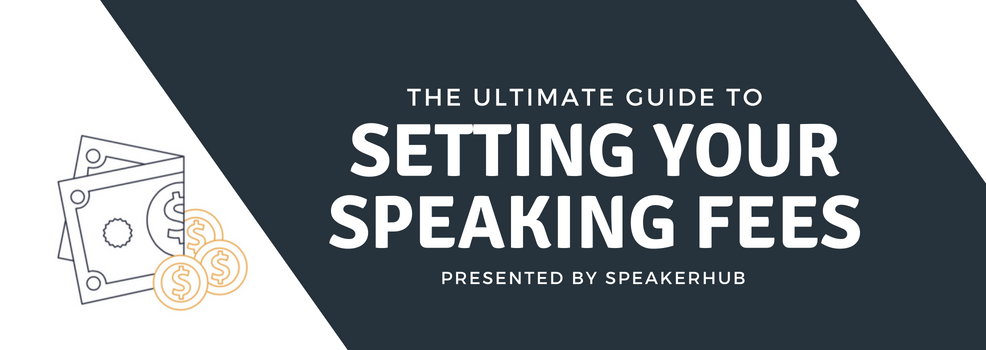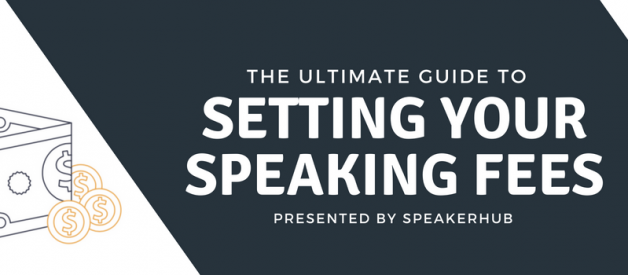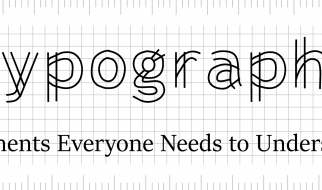
You feel great.
You?ve just waltzed off the stage to roaring applause, and the event organizer hands you a check for $2K for a half hour presentation: you have the perfect job!
You get to excite audiences about something you are passionate about, and the $2K feels like a lot of money for a few minutes on stage.
But then, by the end of the year, you are coming up financially short.
For some reason there doesn?t seem to be enough money to keep this going.
What is going on here?
We don?t want to burst the bubble of good post-stage feelings, but this is an issue many new and mid-level speakers deal with: how do you figure out your fee in a way that covers your needs and leaves you with enough money to build your business?
While $2,000 might seem like a decent paycheck for being on stage for half an hour, once you factor in your costs you will be left with a very small fraction of it.
Often, new speakers don?t take into account the additional costs of maintaining their business.
What happens if you hit a dry spell with no bookings for a few weeks?
Have you included your benefits and taxes?
What if you, or someone close, get sick and you need to take a few weeks off?
What if you want to do some pro bono sessions?
In this guide we explore how to factor these costs into your fee, how to research events to find the right fee for the event, when to offer discounts, and when you should, or should not, speak for free.
Download this article as a free ebook here.
Finding your baseline fee
What you need to figure out is your baseline fee: how much you will need per session for your business to succeed.
Start with how much money you would need to be comfortable in a year (an approximate salary) then reverse engineer it.
Let?s say you made $70,000 last year doing 45 speaking engagements.
This would make your average session rate $1,550.
Here are just a few things to take into consideration:
- Your tax rate (for example: 20%)
- Benefits for you and your family (for example: 25%)
- Speaker bureau or agency fees (for example: 20%)
- Booking agents? fee/assistant?s salary (for example: 10%)
There goes 75% of the fee, leaving you with $388.
This would work out to a yearly income of $17,460.
Is this enough for you to live on, let alone market and build your business?
Instead, work out a rate per session that has the additional costs built in, leaving you with an appropriate amount of funds.
Once you have this, use it as the minimum fee you will speak for.
The minimum fee is not a session rate that you blindly stick to. Instead, look at each speaking and training engagement on an individual basis.
You need to ask yourself:
What can the event afford?
What is fair based on how much the event is bringing in and the value you offer?
From your minimum fee, adjust the fee appropriately.
What can you offer? The value for them
Instead of a set fee, look at creating individual fees for each event you speak at.
Some events can afford to pay their speakers more, and some cannot, so you need to adjust accordingly.
But how do you figure out what they can afford? You could simply ask them, but nine times out of ten, they will underquote.
Instead, do your own research, and ballpark an appropriate figure.
The best place to start is with the information you can easily assess: the ticket prices and sponsorship.
For example:
500 attendees at $300 each: $150,000
10 top-tier sponsors at $10,000 each: $100,000
15 middle-tier sponsors at $8,000 each: $120,000
20 low-tier advertisers at $5,000 each: $100,000
You are looking at a gross budget of roughly $470,000.
Now, of course, that doesn?t mean they have $470,000 to spend on speakers.
Cut that in half for the venue ($235,000) Then in half again for all the additional costs: (everything from coffee to Facebook ads) you are looking at roughly a $117,500 speaker budget.
Let?s say that they have 10 different speakers: this works out to roughly $11,750 per speaker.
But not all speakers are equal ? more experienced, keynote celebrity speakers will get paid more, and lesser known, less influential speakers will get paid less.
So, where do you fit on this scale? You can get a rough idea of this based on how many tickets your presence will sell.
If you are popular and have a dedicated audience you know will show up, and if, when you share the event on social media, people will click the link and buy a ticket, (for the above example, 39 tickets will cover your fee) then you can feel comfortable quoting the $11,750 or more ? however if you are not very well known, or this is a new audience for you, you will probably have to be satisfied with a smaller cut of the speakers? budget.
Adding to your fee and setting up a tier system
There are also additional things you can offer (aside from your presentation) that you can use to bolster your fee.
Businesses and organizations of all kinds set up tier pricing systems (even here at SpeakerHub!) because they are extremely effective.
Here are a few reasons to consider setting up a tier pricing system:
- They help you make more money effectively.
Want some evidence? Check out this pricing example from The Economist.
It?s all about the contrast. Multiple tiers help ?anchor? event organizers into paying more.
Don?t forget that event organizers will pay up to their budget. If they are willing to pay $10,000 but you only charge $1,000, you are losing out on $9,000.
2. They help you expand to suit a wider audience.
The different price points can show you have offerings for all types of events, to suit their needs and budgets.
Plus, everyone likes to see a menu of available options.
3. They help you to explain the value of your services and validate your prices.
By allowing them to pick the appropriate services for their event, you will create a sense of maximized value.
They know what they are getting because they choose it based on what they need.
4. They help you get repeat bookings.
The lower priced tiers can substantially help you get a foot in the door at an organization.
After working with you once, the event organizer, when hiring you again, will often move up to your higher tier packages.
So how do you decide on your price points and what to include in each tier? The three steps below will help.
Step 1: Figure out what the base offerings are that you want to include for every tier
What are your ?base? offerings
Here is an example:
- 1-hour consultation with the organizer on how to customize the talk to their specific audience
- A 30-minute talk (remember: this figure will change based on the event)
- Slides customized with the event?s logo
Step 2: Come up with a list of everything else that you could offer.
To make this list, start by going back to the reasons they want to hire you.
It?s because you have knowledge and you have influence. And from these two categories, you can get creative.
Start by thinking about what the event organizer wants.
Here are some ideas:
- Can you offer training sessions or workshops?
- Will you promote the event on social media? How many posts? Will it include multimedia, like a video? Will you post before, during and after the event?
- Can you use your influence to put them into contact with other experts who could speak or conduct training at the event?
- Do you have access to a mailing list where you could promote the event? (Either your own, or for example, maybe you have a close contact with the CEO of an organization whose audience would be interested in attending the event?)
- Can you offer to do an additional Q&A or to be a panelist in a discussion?
- Can you offer 1-on-1 consultations at the event for a few key attendees?
- Could you put the organizers in contact with potential sponsors?
- Will you be there for the entire event, including the coffee breaks and after party for networking?
- Do you have a report, PDF, or white paper you could offer to the audience for free?
- Do you have a book you could offer for free or at a deep discount?
Now divide this list into the categories based on high-level, mid-level, or low-level.
Step 3: Set the prices for each individual add-on, and create packages.
The final step is to add the base pricing for each tier, list the benefits and put them into packages. You could also sell each service separately as add-ons to your speaking fee.
What?s in it for you? Discounting and speaking for free
Sometimes an event will help you access a completely new audience, promote your organization or service, and increase your influence.
While many event organizers throw around the word ?exposure? ad nauseum, sometimes having access to that new and ideal audience can make a huge difference to your business, and ultimately, your bottom line.
In this case, you could look at waiving certain fees or discounting your speaking fee. The benefit for you will be immense, and with the right audience you will make the money back in no time.
Let?s look at an example. Let?s say you are the CEO of a startup based in California. You have been making some waves around the United States, and building your local and national audience, but it would be very beneficial for you to break into the European Market.
An organizer from London Tech Week heard you speak a few months ago and has emailed you to find out if you might be available for their upcoming conference.
The exposure you would get could help bring you the new, European client base that will help you bring your business to the international level.
If you know your cost of customer acquisition, and you know the likely response rate from an audience, you could discount your speaking fee by your projection of new customer acquisition from the event.
Let?s look at an example:
Your speaking fee baseline is $25,000, and you are going to speak to an audience of 1,500 people.
From your last event, you know that around 10% of the audience will turn into paying clients, and normally, your cost of acquisition is around $100 per client.
This means you will probably end up saving $15,000 in new client acquisition costs, meaning you could reasonably discount your speaking fee by 40%.
Speaking for free
Sometimes an event?s audience is so valuable in terms of influence and new client acquisition, that you can waive your speaking fee entirely, even covering your own travel and expenses ? this is often the case with large-scale, international events like the TED Conference, TechCrunch Disrupt, World Business Forum, SXSW, or The World Economic Forum?just getting on the stage will instantly increase your influence and gain you new clients.
But often, much smaller events will still ask you to speak without compensation.
Many speakers ask us: ?Should I, or shouldn?t I, speak for free??
Here is a quick checklist to help you determine whether speaking at an event for free is worth it:
- You are testing brand new content, and want to try it out in front of a live audience.
- They are offering you something of equal value to your speaking fee that will add to your bottom line.
- For example: They will buy 1000 copies of your book, or you are certain you will make the fee back with new client acquisitions.
- They are offering you something of equal or higher value to your speaking fee that doesn?tactually add to your bottom line, but still has the same value to you.
- For example: A paid trip to Hawaii for you and your partner, or perhaps you will be rubbing shoulders with the top industry thought leaders, celebrities, and experts, which could help raise your profile.
- You genuinely care about the cause or organization, and you want to be involved regardless of the cost.
- For example: It is a pro bono talk to raise funds for a charity you care about.
If an event does not check at least one of these boxes, then politely decline.
Want to find out more about speaking fees? We have some additional resources for you.
- A guide to negotiating your speaking fee
- How to develop multiple revenue streams as a speaker
- How much should you charge? 15 tips for figuring out your speaking fee
- Should you speak for free?
- Money for nothing and speak for free? 10 Tips to succeed as a professional speaker
Download this article as a free ebook here.
Looking for more speaking opportunities? Go to SpeakerHub?s event page and start applying for events looking for speakers with your skills.
This was originally posted on SpeakerHub Skillcamp.


